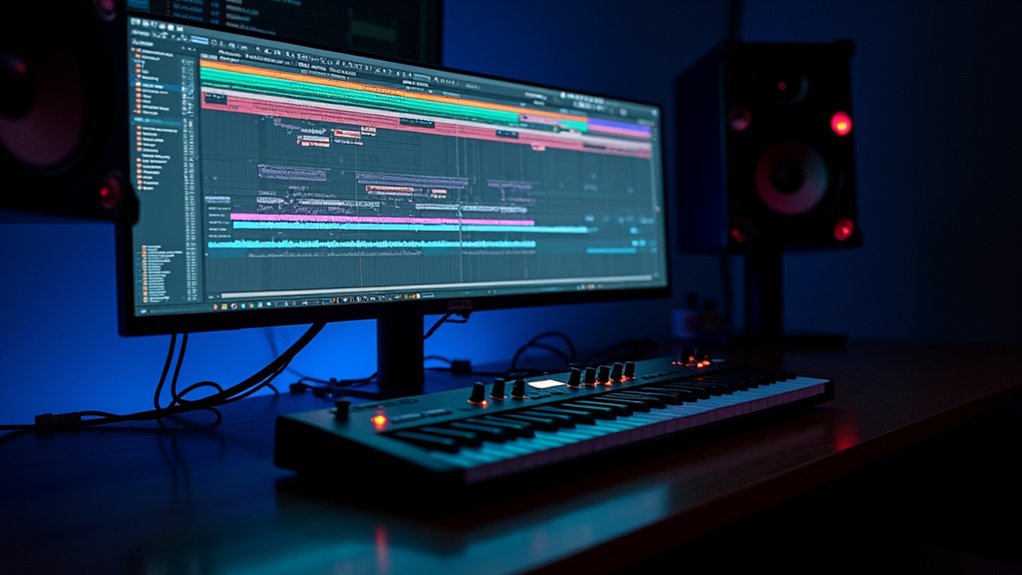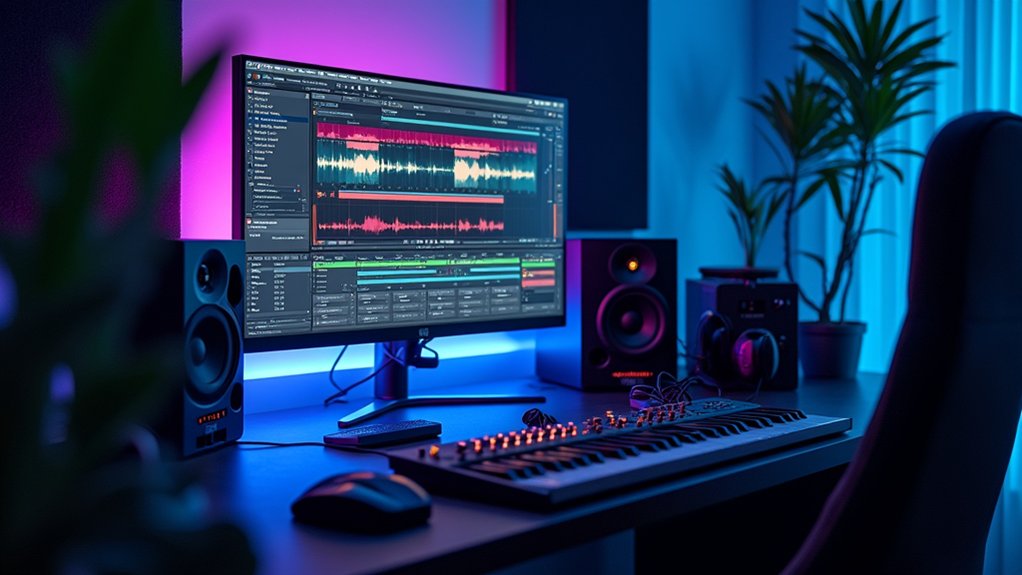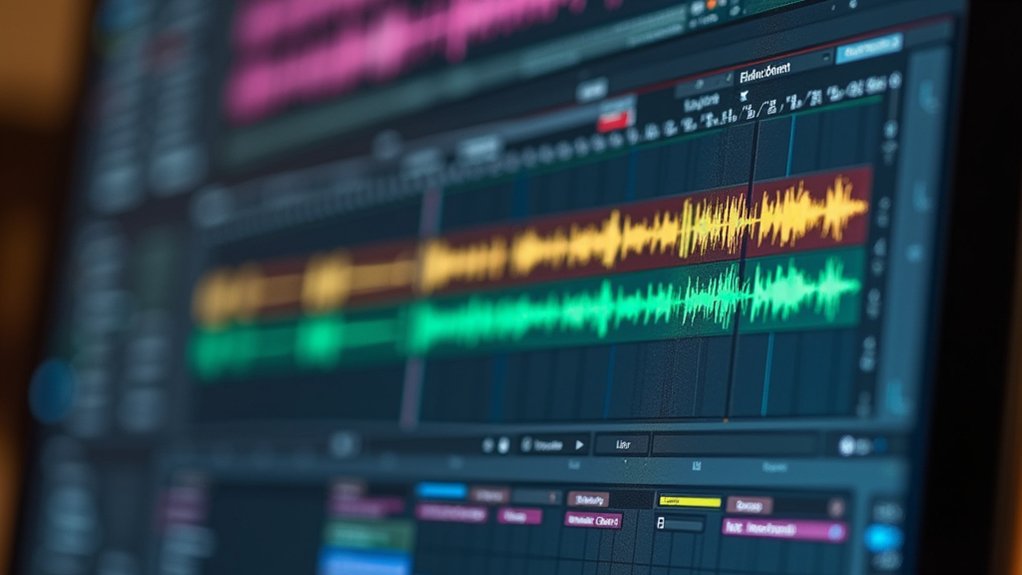FL Keys in FL Studio provides beginners with an efficient workflow for sound design and composition. Users can access diverse presets, manipulate plugin parameters with tactile controls, and assign sounds rapidly using Shift functions. Scale Modes guarantee harmonic accuracy, while Step Sequencer and Note Repeat streamline rhythmic and melodic pattern creation. Integrated mixing features and Score Log enable precise arrangement and spontaneous idea capture. Exploring these foundational techniques sets the stage for mastering more advanced music production tools and strategies.
Key Takeaways
- FL Keys integrates easily with FL Studio, offering intuitive controls for playing, recording, and manipulating piano sounds.
- Use Scale Mode to ensure all notes and chords fit your chosen key, making melodies and harmonies sound musically correct.
- Experiment with presets and sound selection to quickly find inspiring piano tones for different genres and moods.
- Utilize the step sequencer and pads for precise rhythm programming or real-time performance of melodies and chords.
- Adjust volume, pan, and add effects like Fruity Reverb 2 directly from FL Keys for quick and balanced mixing.
Getting Started With FL Keys in FL Studio
When integrating FL Keys with FL Studio, users gain immediate access to a purpose-built MIDI keyboard that supports streamlined workflow and efficient sound design. Getting started requires minimal configuration, as FL Studio automatically recognizes FL Keys’ hardware profile. The device comes in both mini and 37-key sizes, accommodating diverse workspace requirements. Users can make use of four main control sections—modulation wheels, function controls, pads and pots, and transport controls—to directly influence musical elements and parameter adjustments. The Score Log feature is particularly useful for capturing spontaneous MIDI performances, recording the last five minutes of play for later retrieval. Additionally, accessing channel sounds is simplified; pressing Shift + Channel Rack assigns drum or instrument sounds to pads, accelerating the workflow for programming beats and melodic lines within FL Studio. For optimal performance, ensure compatibility with FL Studio by checking for native integration or mapping capabilities, which simplifies setup and enhances usability.
Exploring the FL Keys Interface
Interface design in FL Keys prioritizes direct interaction and streamlined workflow for FL Studio users, featuring dedicated sections for modulation wheels, function controls, pads, pots, and transport controls.
Modulation wheels enable nuanced expression, directly affecting synth parameters such as vibrato or filter sweeps. The pads, arranged for rapid access, serve both performance and composition tasks—particularly when paired with Shift + Channel Rack to trigger specific sounds efficiently.
Function controls and pots provide tactile manipulation of plugin parameters, while Shift + Plugin integration simplifies direct adjustment of Image Line plugins.
The Score Log feature is essential for sound design, automatically capturing up to five minutes of MIDI performance, safeguarding spontaneous ideas.
FL Keys is available in mini and 37-key formats, ensuring flexible integration into diverse studio environments.
Building on the streamlined interaction offered by FL Keys’ interface, effective sound design hinges on mastering preset exploration and sound selection. Users can access a diverse array of presets in FL Keys by utilizing the dedicated function controls, streamlining the process of exploring presets. The keyboard’s pads, accessible via Shift + Channel Rack, further enhance workflow for rapid sound selection. Score Log enables preservation of preferred presets by capturing recent MIDI activity, supporting iterative sound design. Employing scale and note repeat features introduces unique timbral variations within chosen presets. Additionally, the Shift + Plugin command empowers users to simultaneously control multiple Image Line plugins, expanding creative options during sound selection. The table below summarizes core exploration techniques:
| Function | Shortcut | Purpose |
|---|---|---|
| Browse Presets | Function Controls | Exploring presets |
| Pad Selection | Shift + Channel Rack | Sound selection |
| Score Log | Automatic | Preset recall/storage |
| Scale/Repeat | Feature Setting | Variation in presets |
| Multi-plugin Ctrl | Shift + Plugin | Advanced workflow |
Creating Chords With FL Keys
Leverage FL Keys’ Scale Mode to efficiently construct harmonically accurate chord structures within FL Studio. Scale Mode automatically corrects out-of-scale input, ensuring all triggered notes conform to the selected tonal framework—major or minor.
When engaged, Scale Chord Mode enables users to trigger complex chords with a single pad press, greatly accelerating the workflow for composing chord progressions. Integrating Note Repeat with Scale Mode further enhances dynamic chord creation, allowing for rhythmic repetition and nuanced articulation of chords.
Experimentation with various scale types reveals unique chord combinations, expanding creative potential and enabling distinct harmonic textures.
Additionally, FL Keys provides tactile control over chord tracks via dedicated pots for volume and pan, facilitating precise mixing and spatial placement. This workflow streamlines the sound design process for modern music production.
Building Melodies Using FL Keys
Many producers rely on FL Keys’ Scale Mode to constrain melodic input to the selected tonal center, ensuring every note aligns harmonically within the chosen scale. Utilizing this function, users can confidently explore melodic phrasing without fear of introducing out-of-key notes. The Note Repeat feature enhances workflow by enabling the creation of precise rhythmic motifs—simply hold down a pad, and FL Keys delivers seamless, quantized note repetitions. Scale Chord Mode further streamlines harmony, allowing instant chord triggering and facilitating melodic layering. By alternating between major and minor scale modes, users can quickly shift emotional context. Utilizing FL Keys’ modulation wheels and function controls, dynamic expression and pitch movement can be embedded directly into melodic lines. To create a sense of emotional impact, experiment with different scales like Dorian to expand your melodic palette.
Recording Techniques for Beginners
When recording drum patterns in FL Studio, beginners can choose between a hands-on NPC style or the step sequencer for precise sound placement. The step sequencer offers granular control over timing and arrangement, streamlining the workflow for structured beats. Utilizing these techniques allows users to establish a solid rhythmic foundation before layering melodic elements with FL Keys. To enhance their skills, beginners should explore various mixing techniques to improve sound quality and ensure each element of their track stands out effectively.
Laying Down Drum Patterns
Initiate the drum programming process by selecting either the NPC style or the step sequencer method, both accessible via the FL Keys keyboard within FL Studio.
For intuitive drum patterns, users can press Shift + Channel Rack, enabling direct access to channel sounds on the pads for real-time triggering during recording sessions.
Engaging the metronome provides a stable reference tempo, vital for maintaining precise rhythmic alignment within the drum patterns.
Step sequencer mode allows for granular control, enabling users to place hits at specific steps, facilitating detailed timing and rhythm adjustments.
The workflow is further optimized by the Undo function, offering immediate correction of input errors.
This structured approach guarantees consistent, in-sync drum programming, laying a solid rhythmic foundation for subsequent musical layers.
Using Step Sequencer
Although FL Studio offers multiple drum programming methods, the step sequencer stands out for its accuracy and control in pattern creation. Accessing the channel sounds on pads via Shift + Channel Rack, users can intuitively input drum events by clicking on the grid, activating or deactivating notes with high precision. Engaging the metronome guarantees rhythmic consistency, an essential factor when recording drum patterns for electronic or acoustic sound design. If errors occur during sequencing, the Undo function allows immediate reversion, supporting non-destructive editing and workflow efficiency. Experimentation between NPC style and step sequencer methods can reveal personalized creative processes. The following table illustrates the visual flow:
| Step Sequencer | Metronome | Undo |
|---|---|---|
| Kick | Tick | Revert |
| Snare | Beat | Restore |
| Hi-Hat | Click | Correct |
Utilizing Step Sequencer and NPC Style
Producers can achieve precise rhythmic programming with the step sequencer, arranging drum hits and melodic elements on a grid for exact timing.
Alternatively, NPC style drum programming enables hands-on performance, triggering sounds in real time for a more humanized groove.
The integration of both methods within FL Studio offers flexible workflow options, accommodating both structured sequencing and live input techniques.
Step Sequencer Precision
While working within FL Studio, the step sequencer offers granular control over rhythmic programming, enabling precise placement of sounds in the project.
By accessing the step sequencer with Shift + Channel Rack, users can visually align each note and percussion hit, optimizing timing and rhythm in their compositions. This workflow facilitates intricate sound design, allowing for the creation of complex patterns by simply adjusting step positions.
Activating the metronome during step sequencing further enhances timing accuracy, providing an audible reference point throughout the recording process.
The step sequencer’s layout supports rapid iteration, as the undo function enables quick correction of misplaced notes, streamlining experimentation.
Through these features, FL Studio’s step sequencer empowers producers to achieve professional-level rhythmic precision in their music projects.
NPC Style Drum Programming
Building on the step sequencer’s precise control, NPC style drum programming in FL Studio leverages the Channel Rack and pad assignment to streamline real-time rhythm creation.
This workflow enables fast iteration and live input, combining tactile performance with editable sequencing. Producers utilize the Channel Rack by pressing Shift + Channel Rack to quickly assign drum samples to individual pads, maximizing immediate playability.
The Step Sequencer is used for precise placement of hits, while Note Repeat provides rapid-fire rolls and fills, essential for dynamic drum patterns.
- Assign drum sounds to Channel Rack pads for hands-on triggering
- Use Step Sequencer to program, edit, and loop intricate rhythms
- Activate Note Repeat for consistent, fast drum rolls and varied timing
- Record patterns in real-time, synchronizing with the metronome
- Instantly undo changes to encourage creative experimentation
Enhancing Tracks With Note Repeat and Scale Mode
Transforming simple patterns into dynamic arrangements, the Note Repeat and Scale Mode features in FL Keys provide precise control over rhythm and harmony.
Utilizing Note Repeat, users can program rapid-fire rhythmic patterns by holding down a pad, with timing and rate adjustments accessible via the leftmost keys. This enables intricate hi-hat rolls or melodic arpeggios with consistent tempo.
Scale Mode guarantees that every note played conforms to the selected scale, automatically correcting out-of-scale notes for cohesive melodic development. Multiple scale types, including major and minor, are available for real-time tonal adaptation.
For harmonic enhancement, Scale Chord Mode allows entire chords to be triggered from a single pad, streamlining chord progression creation and adding depth to arrangements without complex fingerings, optimizing workflow for efficient sound design.
Basic Mixing and Control Features
The FL Keys provides direct access to mixing parameters, allowing users to manipulate channel faders, pan positions, and plugin controls without leaving their hardware interface. By utilizing specific key combinations, precise volume and stereo placement adjustments can be executed efficiently during the production workflow. This tactile integration streamlines sound design and mixing tasks within FL Studio. Regularly scanning for new plugins ensures that any additions are recognized and integrated seamlessly, enhancing the overall music production experience.
Hands-On Mixing Controls
Achieving efficient sound design in FL Studio often relies on direct, tactile interaction with mixing controls, and the FL Key keyboard delivers this through its dedicated pots for channel fader adjustments.
This hands-on mixing control empowers users to sculpt their mixes with precision, improving workflow efficiency. Integrated shortcuts like Shift + Plugin provide immediate access to Image Line plugin parameters, streamlining the manipulation of sound design elements.
Similarly, Shift + Channel Volume ensures rapid control over channel volumes, while Shift + Mixer Pan brings intuitive panning adjustments to the user’s fingertips.
These features allow for seamless, dynamic interaction with the DAW’s mixing console.
- Immediate channel fader adjustments via dedicated pots
- Shift + Plugin enables direct plugin parameter control
- Shift + Channel Volume facilitates efficient level balancing
- Shift + Mixer Pan offers precise panning adjustments
- Enhanced workflow through tactile, hands-on mixing control
Panning and Volume Adjustments
Steering volume and panning adjustments in FL Studio becomes highly efficient with the FL Keys keyboard, as its dedicated pots enable direct, tactile manipulation of channel faders and stereo placement.
This hardware integration allows for rapid workflow, minimizing reliance on mouse clicks. For precise volume adjustments, users can employ the shortcut Shift + Channel Volume, granting granular control over each channel’s level within the mix.
Panning is similarly streamlined by using Shift + Mixer Pan, facilitating accurate spatial positioning of sounds in the stereo field. Additionally, the Shift + Plugin function extends hands-on control to Image Line plugins, optimizing the mixing process.
These features collectively simplify mixing, giving users immediate access to both volume and panning for intricate sound design and balanced audio output.
Tips for Layering and Arrangement
Leverage advanced layering techniques within FL Studio’s FL Keys to construct intricate arrangements and enhance sonic depth. Employing precise workflow strategies allows for effective sound design and musical cohesion. Integrating features like Scale Mode and Note Repeat not only streamlines the creative process but also guarantees technical accuracy in tonal and rhythmic structures. Consider the following techniques for ideal layering and arrangement in FL Keys:
- Use Scale Mode to automatically conform layered harmonies and melodies to the selected key, preventing dissonant notes.
- Employ Note Repeat to create rhythmic complexity when layering percussive or melodic patterns.
- Capture spontaneous ideas with Score Log and repurpose them as new layers in your arrangement.
- Adjust individual layers’ volume and panning with FL Keys’ dedicated pots for balanced spatial placement.
- Combine contrasting scale types across layers for a rich, multidimensional tonal palette.
- Implement Fruity Reverb 2 to add depth and spatial characteristics to your layers, enhancing the overall emotional impact of the arrangement.
Frequently Asked Questions
Is FL Studio Easy for Beginners?
FL Studio provides an intuitive workflow for beginners in music production, offering beginner tips, user-friendly interfaces, and accessible sound design tools. Its step sequencer, integrated support features, and structured tutorials streamline the learning curve for novice producers.
Can You Make Music With Just FL Studio?
The current question examines whether complete music production is achievable using only FL Studio. Its software features—comprehensive step sequencer, piano roll, built-in effects—enable efficient workflow. For beginners, integrated tools and sound design options streamline processes and enhance creative output.
Can I Learn FL Studio on My Own?
Learning FL Studio independently is feasible, as self taught musicians leverage extensive online resources, community forums, and official documentation. Effective practice techniques, including workflow optimization and iterative sound design, enable mastery through experimentation, hands-on exploration, and systematic review of compositions.
Is FL Studio Enough to Make Music?
FL Studio features extensive music production tools, efficient software integration, and advanced sound design capabilities. Its workflow-focused architecture enables users to compose, arrange, mix, and master tracks, making it sufficient for producing professional-quality music independently.
Conclusion
Utilizing FL Keys in FL Studio, beginners can efficiently craft piano-driven tracks by mastering its interface, preset management, and chord construction. Integrating FL Keys with the step sequencer and utilizing features like Note Repeat and Scale Mode streamlines melodic development and rhythmic precision. Basic mixing controls enable further sound sculpting, while thoughtful layering and arrangement techniques enhance musical depth. Overall, FL Keys provides a robust, workflow-oriented foundation for sound design and creative music production within FL Studio.




